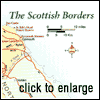|
The Scottish Borders

From the south, there are four main routes into the Scottish
Borders, each offering a particular introduction to this distinctive region. The
upgraded A1 follows the east coast and is the easiest to drive with long stretches
of dual-carriageway and pleasant coastal views.
The alternative A68 through Carters Bar is undulating
and scenic although slightly more demanding for the driver. It crosses the pastoral
and hilly heart of Borders country. The A697 through Coldstream is similar and from
the west the A7, signposted from the M6 as the tourist route for the Borders and
Edinburgh, passes through the market towns of Hawick and Selkirk.
Despite acting as a crash barrier through many tumultuous
centuries between Britain's two largest countries, the Borders is now one of the
most peaceful and gentle of Scottish regions. Its rolling country roads and picturesque
villages, compared to other regions, are quiet, even at their busiest times. In the
east, quilted rolling landscapes are occasionally interrupted by higher elevations
such as the Eildon Hills, whereas the west is more remote and wild in character.
The larger towns of Hawick, Jedburgh and Peebles are more greatly influenced by the
modern world with super-stores set next to woolly jumper and fishing tackle shops.
 The river Tweed contributes immensely to the character of
the region. Therefore the Borders are famous for fishing with salmon beats, depending
on the season, available throughout the district. Trout fishing is also available
from March to October on some rivers. The river Tweed contributes immensely to the character of
the region. Therefore the Borders are famous for fishing with salmon beats, depending
on the season, available throughout the district. Trout fishing is also available
from March to October on some rivers.
The area's history has contributed greatly to local
traditions and perhaps even the local disposition. A predominant and persistent factor
over nearly 400 years was the aggression between Scotland and its southerly neighbour,
England. Between 1296 and the Union of the Crowns in the early seventeenth century,
the Borders was a battleground (or the main route to one) between the two constantly
warring nations. This virtual no-man's-land, as it became, fell into a lawless state
where robbery and cattle stealing were rife, even amongst close neighbours. Not until
the Union of the Crowns did the wild Borders settle into the peaceful province that
it is today.
|


